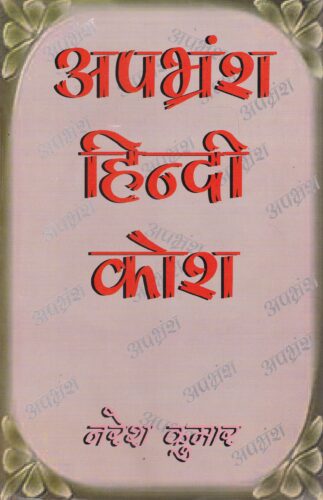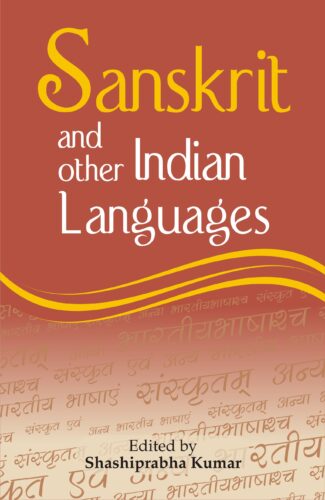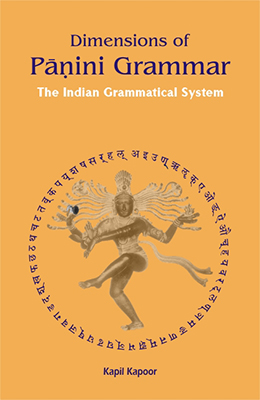

Apbharamsa Hindi Kos...
Apbharamsa Hindi Kosha
Apabhramsa-Hindi-Dictionary by: Naresh KumarThis Dictionary of Hindi Apabhramsa gives in detail the grammatical importance of words, their meanings, correct spellings, the alternate words and their various usages as mentioned by lexicographer Naresh Kumar.
₹1,500.00 Original price was: ₹1,500.00.₹1,350.00Current price is: ₹1,350.00.
ISBN: 9788124601365
Year Of Publication: 1999
Edition: 1st
Pages : xlv, 869
Language : Hindi
Binding : Hardcover
Publisher: D.K. Printworld Pvt. Ltd.
Size: 23 cm.
Weight: 1500
This Dictionary of Hindi Apabhramsa gives in detail the grammatical importance of words, their meanings, correct spellings, the alternate words and their various usages as mentioned by lexicographer Naresh Kumar.

- Sale!Philosophy of Language in Classical Indian Tradition by: K.S. Prasad
₹850.00Original price was: ₹850.00.₹765.00Current price is: ₹765.00.Philosophical query into the working of language has occupied an important place in the rich tradition of thought in India since the ancient times. This book throws light on various debates in classical Indian Philosophical tradition concerning the structure of language and meaning. Papers in this book have been arranged in four groups basing on their thematic composition. The book begins with the general issues relating to language as figured in classical schools of Indian philosophy. Papers dealing with the semantic structure of language as discussed by Bhartrhari in his Vakyapadiya follow this. The next set of papers is related to some of the important semantic notions of Nyaya philosophy of language. In this respect notions like sense, reference, proper names, meaning, etc., have figured in for discussion. The last set of papers is concerned with the import of sentences wherein papers dealing with Purva-Mimamsa are included. One of the significant features of this volume is that some of the issues and problems in Indian Philosophy of language have been approached from the contemporary Western perspective with a view to explicate and evaluate them in a better way and this would be of considerable interest to scholars and students of philosophy, particularly those involved in the study of classical Indian philosophy.
- Sale!Linguistic Traditions of Kashmir by: Mrinal Kaul, Ashok Aklujkar,
₹1,250.00Original price was: ₹1,250.00.₹1,125.00Current price is: ₹1,125.00.The present volume mainly consists of original research papers. It is not a collection or anthology in which specialists of the different aspects of Kashmirian use or study of language were invited to write essays surveying the aspects best known to them or to produce state-of-the-art reports about the scholarly study of the aspects. An effort, however, has been made in the Introduction to provide the general background that a reader may need in order to situate the papers in the proper intellectual and historical context. The Introduction further outlines the themes that could and should be particularly explored to lead us to a fuller and sharper understanding of Kashmir’s analytical engagement with language. The appendices toward the end of the volume then complement the Introduction by presenting objective and practical information about the manuscripts etc. of works in Sanskrit. The volume could connect the results of the work done in the past with the work to be done in the future by adding to knowledge in the present because of the articles it attracted from veteran as well as upcoming researchers. The reader will find here discussions bearing upon texts, as well as discussions bearing upon the authors of texts; discussions devoted to elucidating single passages, as well as discussions exploring instances of intertextuality; and discussions exclusively addressing individual grammars, as well as discussions engaging in the relation of one grammatical school with another.
- Sale!Indic Scripts by: P.G. Patel, Pramod Pandey, Dilip Rajgor,
₹1,400.00Original price was: ₹1,400.00.₹1,260.00Current price is: ₹1,260.00.This volume presents the advances in the ongoing research on Brahmi and its daughter scripts used in the present day India. It brings together two main trends: evolutionary-historical development and linguistic grounding. This is the first attempt to cross-fertilize palaeography and linguistics. The palaeographic papers cover the main issues in the decipherment of the Indus Valley script, the origin and evolution of Brahmi, and the palaeographic methods and considerations employed in the decipherment of scripts. These present different trends and arguments of writers on the origin of Brahmi as having been around the Mauryan era or at a much earlier stage, relate to broader historical and cultural issues. They also deal with the need for the use of established and more current palaeographic techniques in classifying regional and stylistic variants of scripts. The linguistic papers in the volume explore the issues of the roots of the orthographic unit aksara in Vedic phonetics, its claim as a minimal articulatory phonetic unit, and the properties of Brahmi as a generative writing system. The philosophical and linguistic underpinning of the concept aksara is shown to thread its use in the varieties of treatises, from the Vedas to phonetic texts. The papers help in providing linguistic evidence for historical accounts of the script as an invention at a given time or as an evolving evolutionary system, apart from relating the development of the script to the linguistic history of India. Palaeographers epigraphists, linguists and computational scientists, will find this volume interesting and useful.
- Sale!Sanskrit and Other Indian Languages by: Shashi Prabha Kumar
₹440.00Original price was: ₹440.00.₹396.00Current price is: ₹396.00.This book is mainly a compilation of articles which were primarily presented at the Sanskrit Week Programme organized by the Special Centre for Sanskrit Studies, Jawaharlal Nehru University, New Delhi from 714 August 2006. A few articles have, however, been added later on. Sanskrit and Other Indian Languages features the influence and interaction of Sanskrit with Prakrit, Hindi Apabhramsha, Urdu, Bangla, Tamil, Telugu, Kannada, Malayalam, Assamese, Punjabi, Kashmiri and Gujarati. It covers various aspects of mutual reciprocation between Sanskrit and other Indian languages such as Þ conceptual, structural, grammatical, historical, linguistic, colloquial as well as literary. Issues of oral and written forms of language as also of textual translations have been dealt with by Sanskrit scholars who are well-versed in respective Indian languages. Finally, there is an article which argues for Sanskrit as a National Language of India. This book is a modest attempt to convey the inherent thought-pattern of Indian mind basically enshrined in Sanskrit but expressed through variety of verbal forms across the country.
- Sale!Dimensions of Panini Grammar by: Kapil Kapoor
₹950.00Original price was: ₹950.00.₹855.00Current price is: ₹855.00.Leonard Bloomfield described Panini’s Ashtadhyayi (7th century bc) as ‘one of the greatest monuments of human intelligence.’ It is a complete, explicit and comprehensive grammar of both spoken and textual (compositional) Sanskrit. Most of the reputed and renowned Indian and foreign universities running courses on Indian knowledge systems, study it for its principles of analysis, organization and description. What is of great interest is the theoretical framework that informs this grammar, a framework that has remarkable power to describe human languages, particularly the Indian languages.
Panini is the watershed in the linguistic history of India. Before Panini, there was extensive work in phonetics, in morphology and lexicon (in the patha tradition) and in nirvacana (etymology). There is evidence also of the existence of several schools of grammar. In what is characteristic of the Indian intellectual traditions, Panini distilled the available grammatical knowledge and put it in 32000 syllables — as if, it has been said, an ocean has been accommodated in a cow’s hoof-mark. After Panini, a whole tradition developed and produced rich works by Patanjali, Candrakirti, Jainendra, Bhartrihari, Bhojraja, Hemacandracarya, Bhattoji Dikshita, Nagesha Bhatta and many others. It also inspired work in literature and philosophy and has left its mark on the entire intellectual tradition. In the modern period, there is a spread of Ashtadhyayi studies round the globe and it has proved to be of great interest for the study of knowledge representation in the departments of system sciences.
A comprehensive study of the different dimensions of this wonderful grammar enlarges and alters the conceptual horizons of young minds and of all those who care to be associated with the Indian grammatical systems. This book is a record of that adventure.







